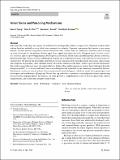Avian Toxins and Poisoning Mechanisms
Author(s)
Yeung, Kara A.; Chai, Peter R.; Russell, Brendan L.; Erickson, Timothy B.
Download13181_2022_Article_891.pdf (2.205Mb)
Publisher with Creative Commons License
Publisher with Creative Commons License
Creative Commons Attribution
Terms of use
Metadata
Show full item recordAbstract
Abstract
All around the world, there are species of birds that have developed the ability to acquire toxic chemicals in their bodies making them less palatable or even lethal when consumed or contacted. Exposure to poisonous bird species is rare among humans, yet their poisons can produce serious clinical outcomes. In this study, we conducted a literature search focusing on seven avian species: the pitohuis (Pitohui spp.), blue-capped ifrita (Ifrita kowaldi), European quail (Cortunix corturnix coturnix), spur or spoor-winged goose (Plectropterus gambensis), North American ruffed grouse (Bonasa umbellus), Brush bronzewings (Phaps elegans), and European hoopoes and woodhoopoes (Upupa epops and Phoeniculus purpureus, respectively). We present the geographic distribution of each poisonous bird, toxin physiology and origin, clinical signs and symptoms of poisoning, cases of human toxicity if available and discuss the birds’ ability to prevent self-intoxication. Our results suggest that most cases of contact with toxic birds produce mild symptoms as most of these birds apart from the European quail (C. c. corturnix) and North American ruffed grouse (B. umbellus) are not commonly consumed by humans. Furthermore, we discuss several methods of toxin acquisition in these bird species, which are mostly diet acquired apart from the hoopoes and woodhoopoes (Upupa and Phoeniculus spp.) who have a symbiotic relationship with chemical-producing bacteria in their uropygial glands. In summary, our study provides a comprehensive review of the toxic physiology, clinical manifestations, and evolutionary insight to avian toxins.
Date issued
2022-04-26Department
Koch Institute for Integrative Cancer Research at MITPublisher
Springer US
Citation
Yeung, Kara A., Chai, Peter R., Russell, Brendan L. and Erickson, Timothy B. 2022. "Avian Toxins and Poisoning Mechanisms."
Version: Final published version